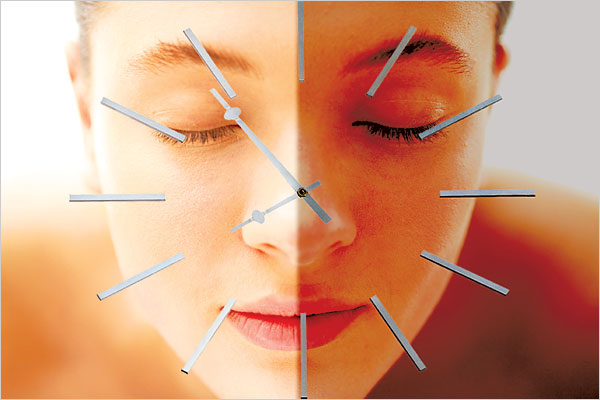
Did you know that your skin keeps time?
July 29, 2015
Our skin acts as the interface between our bodies and the environment. It has to be expertly equipped to deal with nature’s patterns, fine-tuning itself to changes in temperature, UV, light and humidity, while preventing pathogens from entering and moisture from evaporating. It can only do this if it has a sense of “time,” however, and this is the key to the skin’s own rhythmic patterns. But does the skin really keep time?
The Clock
Biological clocks that sync an organism with the earth’s rotation around its axis are pretty universal; you can find a time-keeping system in organisms from cyanobacteria to to fungi to vertebrates like us. We have a “master clock” in the brain that controls our circadian rhythms. This master clock is actually a group of nerve cells located in the suprachiasmatic nucleus, an area of the brain just above where the optic nerves cross. But this is where it gets wild — recent scientific discoveries have uncovered peripheral clocks in the body, including a separate clock mechanism in skin cells.
The oscillators found in various skin cells, as in the pigment-producing melanocytes, the collagen-producing fibroblasts and even skin stem cells, coordinate with each other and the brain’s central clock to drive rhythmic functions in the skin. Circadian variations affect virtually all skin functions, from barrier recovery and sebum secretion to hydration levels and cell renewal.
Night and day
During the day, your skin is is busy warding off intruders and protecting the body from UV damage and oxidation (pollution). At night, while sleeping, the skin (just like the brain) goes into repair-mode, growing new skin cells, deleting damaged ones, and bringing fresh blood to the surface for cycling oxygen and nutrients (this is likely the best time to apply those collagen-enhancing retinoids). Sebum (oil) production peaks in the afternoon — take a look at your T-Zone right after lunch and you may see anything from an extra sheen to a downright oil spill. Trans-epidermal water loss (think: dehydration) peaks at night, so it’s best to layer on an extra level of protection to keep your skin from drying out while you sleep, especially in low humidity climates and during the fall/winter. Then there’s melatonin: Apart from making you sleepy, it is also a powerful antioxidant, especially effective at preventing UV-induced damage. A recent study demonstrated that mice exposed to UV radiation in the morning showed an increased incidence of skin cancer, as opposed to mice exposed in the afternoon. Since we humans have the opposite circadian cycle as the nocturnal mice, these results suggest our skin is most susceptible to the afternoon UV radiation — so be sure to wear sunscreen in the afternoon, when our skin’s DNA-protecting defenses are down.
Sleep Deprivation, Skin Deprivation
A lack of sleep is linked to a host of issues throughout the mind and body. On the skin, it’s reflected as an impaired barrier, more inflammation and, yes, premature aging. Stress, jet lag and other factors that reduce sleep can result in a suppressed immune response and altered inflammatory molecules, which can then trigger or worsen acne and other inflammatory conditions.
Several studies have determined that travel across times zones alters hormonal patterns linked to circadian rhythm, such as diurnal rhythms of melatonin and cortisol, even resulting in deficits in learning and memory — no wonder we don’t perform up to par after a long restless flight! For any frequent traveler, the takeaway is: Get enough sleep on the ground, wear sunscreen to protect skin from UV radiation (window-seat lovers and pilots, beware), and stay hydrated.
Keep in mind, the skin’s time-keeping machinery is synced with daylight and your sleep/wake cycle. When you disturb the circadian rhythm, you alter all the cellular functions of the body. Which could have devastating effects on our bodies. With all the new science regarding the impact of sleep on skin function, the term “beauty sleep” is far more important than it implies.




